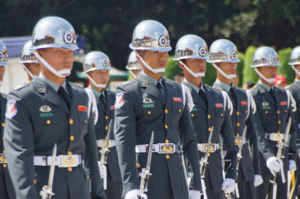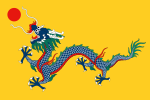Imperial Guard (China)
| Imperial Guard | |
|---|---|
| 侍衛 | |
 Chinese Imperial Guards during a parade | |
| Active |
1898–1945 (as part of Imperial Army) 1946–present (under the Ministry of Police) |
| Country |
|
| Allegiance | Emperor of China |
| Type | Army |
| Role |
Infantry Cavalry Artillery |
| Size |
5 Divisions (former) 3 Battalions (modern) |
| Garrison/HQ | Beijing |
| Engagements |
Coup of 1898 Second Sino-Japanese War |
| Insignia | |
| Yellow Dragon Flag |
 |
| Imperial Standard of the Emperor |
 |
The Imperial Guard (Chinese: 侍衛; pinyin: shìwèi) is a branch of the Ministry of Police of China that is tasked with the protection of the Emperor, the Imperial family, residences, and immediate vicinity. As with other state security agencies the Imperial Guard is considered a military service just like the Armed Forces (中华帝国武装部队) and its members wear military uniforms. Headquartered in Forbidden City and the Summer Palace, Beijing, the modern Imperial Guard consists of about 7,000 personnel.
Established in the early Qing Dynasty, the Imperial Guard was reorganised during the early 1900s into the Imperial Guards Division which consisted of 10,000 men. During the Second Sino-Japanese War it grew into a quasi-independent branch of the Imperial Chinese Army, becoming an elite corps of the Army rather than Household troops in direct attendance of the Qing Emperor. The Guard drew on commoners for enlisted soldiers while the officer corps included many Manchu imperial princes. From 1931 to 1945, it was organised into the Guards Army which included three infantry and two cavalry divisions, having a total of about 99,000 men, and it saw action in the battles of Beijing, Hebei, Shanghai, Nanjing and others. After the war it was reformed into an agency of the Ministry of Police tasked with executive protection of the Imperial Household and police work in Beijing. Since 1999, it has been organised into the Household Guards Battalion, the State and Diplomatic Security Battalion, and the Honor Guard Battalion.